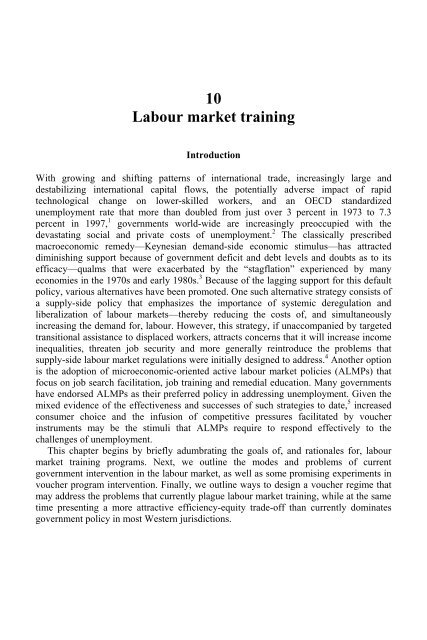Rethinking the Welfare State: The prospects for ... - e-Library
Rethinking the Welfare State: The prospects for ... - e-Library
Rethinking the Welfare State: The prospects for ... - e-Library
You also want an ePaper? Increase the reach of your titles
YUMPU automatically turns print PDFs into web optimized ePapers that Google loves.
10<br />
Labour market training<br />
Introduction<br />
With growing and shifting patterns of international trade, increasingly large and<br />
destabilizing international capital flows, <strong>the</strong> potentially adverse impact of rapid<br />
technological change on lower-skilled workers, and an OECD standardized<br />
unemployment rate that more than doubled from just over 3 percent in 1973 to 7.3<br />
percent in 1997, 1 governments world-wide are increasingly preoccupied with <strong>the</strong><br />
devastating social and private costs of unemployment. 2 <strong>The</strong> classically prescribed<br />
macroeconomic remedy—Keynesian demand-side economic stimulus—has attracted<br />
diminishing support because of government deficit and debt levels and doubts as to its<br />
efficacy—qualms that were exacerbated by <strong>the</strong> “stagflation” experienced by many<br />
economies in <strong>the</strong> 1970s and early 1980s. 3 Because of <strong>the</strong> lagging support <strong>for</strong> this default<br />
policy, various alternatives have been promoted. One such alternative strategy consists of<br />
a supply-side policy that emphasizes <strong>the</strong> importance of systemic deregulation and<br />
liberalization of labour markets—<strong>the</strong>reby reducing <strong>the</strong> costs of, and simultaneously<br />
increasing <strong>the</strong> demand <strong>for</strong>, labour. However, this strategy, if unaccompanied by targeted<br />
transitional assistance to displaced workers, attracts concerns that it will increase income<br />
inequalities, threaten job security and more generally reintroduce <strong>the</strong> problems that<br />
supply-side labour market regulations were initially designed to address. 4 Ano<strong>the</strong>r option<br />
is <strong>the</strong> adoption of microeconomic-oriented active labour market policies (ALMPs) that<br />
focus on job search facilitation, job training and remedial education. Many governments<br />
have endorsed ALMPs as <strong>the</strong>ir preferred policy in addressing unemployment. Given <strong>the</strong><br />
mixed evidence of <strong>the</strong> effectiveness and successes of such strategies to date, 5 increased<br />
consumer choice and <strong>the</strong> infusion of competitive pressures facilitated by voucher<br />
instruments may be <strong>the</strong> stimuli that ALMPs require to respond effectively to <strong>the</strong><br />
challenges of unemployment.<br />
This chapter begins by briefly adumbrating <strong>the</strong> goals of, and rationales <strong>for</strong>, labour<br />
market training programs. Next, we outline <strong>the</strong> modes and problems of current<br />
government intervention in <strong>the</strong> labour market, as well as some promising experiments in<br />
voucher program intervention. Finally, we outline ways to design a voucher regime that<br />
may address <strong>the</strong> problems that currently plague labour market training, while at <strong>the</strong> same<br />
time presenting a more attractive efficiency-equity trade-off than currently dominates<br />
government policy in most Western jurisdictions.


